London’s Top 12 Banksy Murals

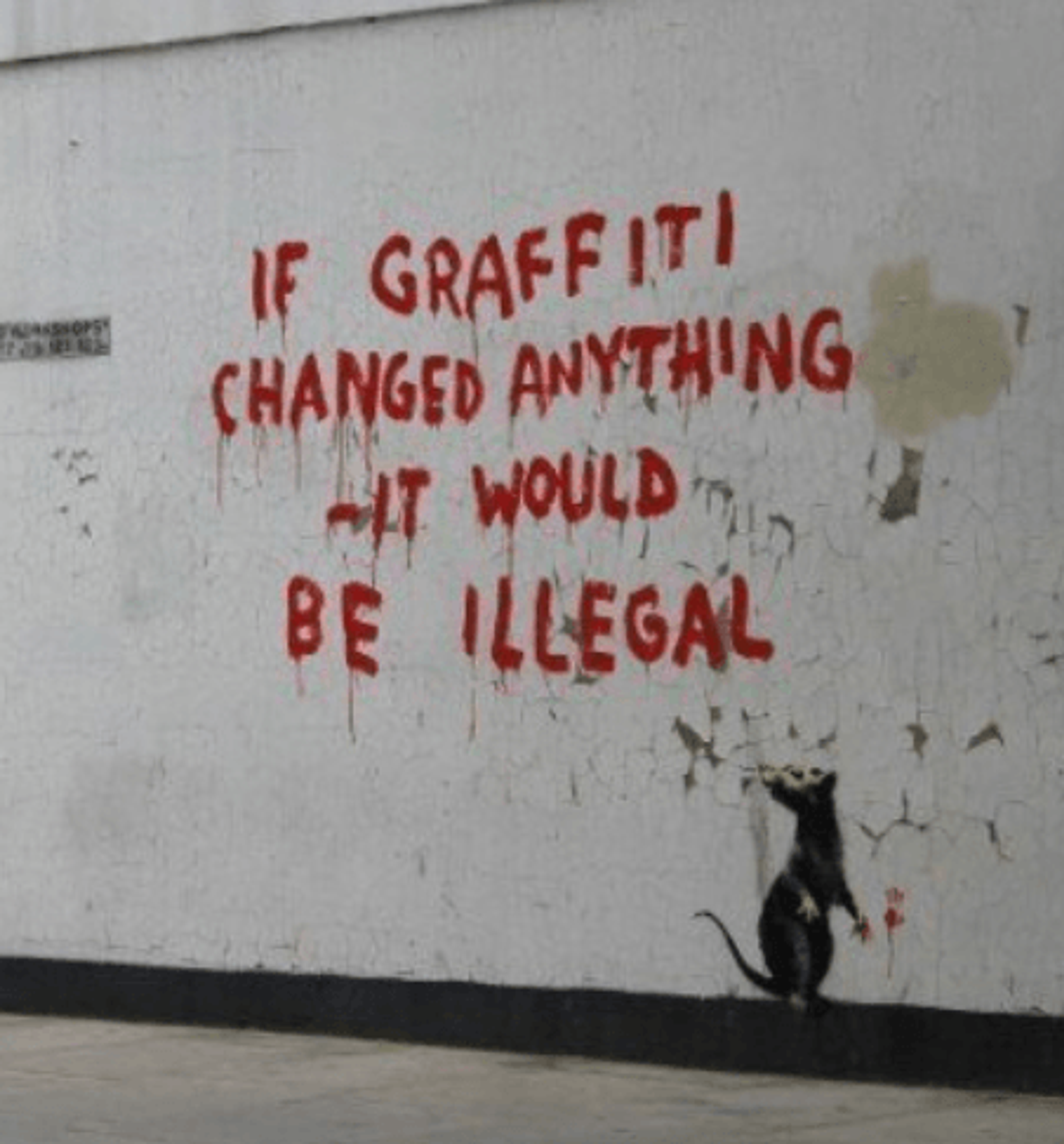 If Graffiti Changed Anything It Would Be Illegal © Banksy 2011
If Graffiti Changed Anything It Would Be Illegal © Banksy 2011
Banksy
269 works
Since he first appeared on the street art scene in Bristol around the early 2000s, Banksy’s art has conquered city streets, buildings, the London Underground and gallery walls around the world from Paris to New York to the West Bank and even his own bathroom during lockdown. London has some of the best-known public artworks by the notorious artist, with each mural having its own unique story – even though many have since then been removed, covered with plexiglass for protection, vandalised or peeled off by thieves. Here’s our personal top 12, their date of appearance, location and the message behind the art.
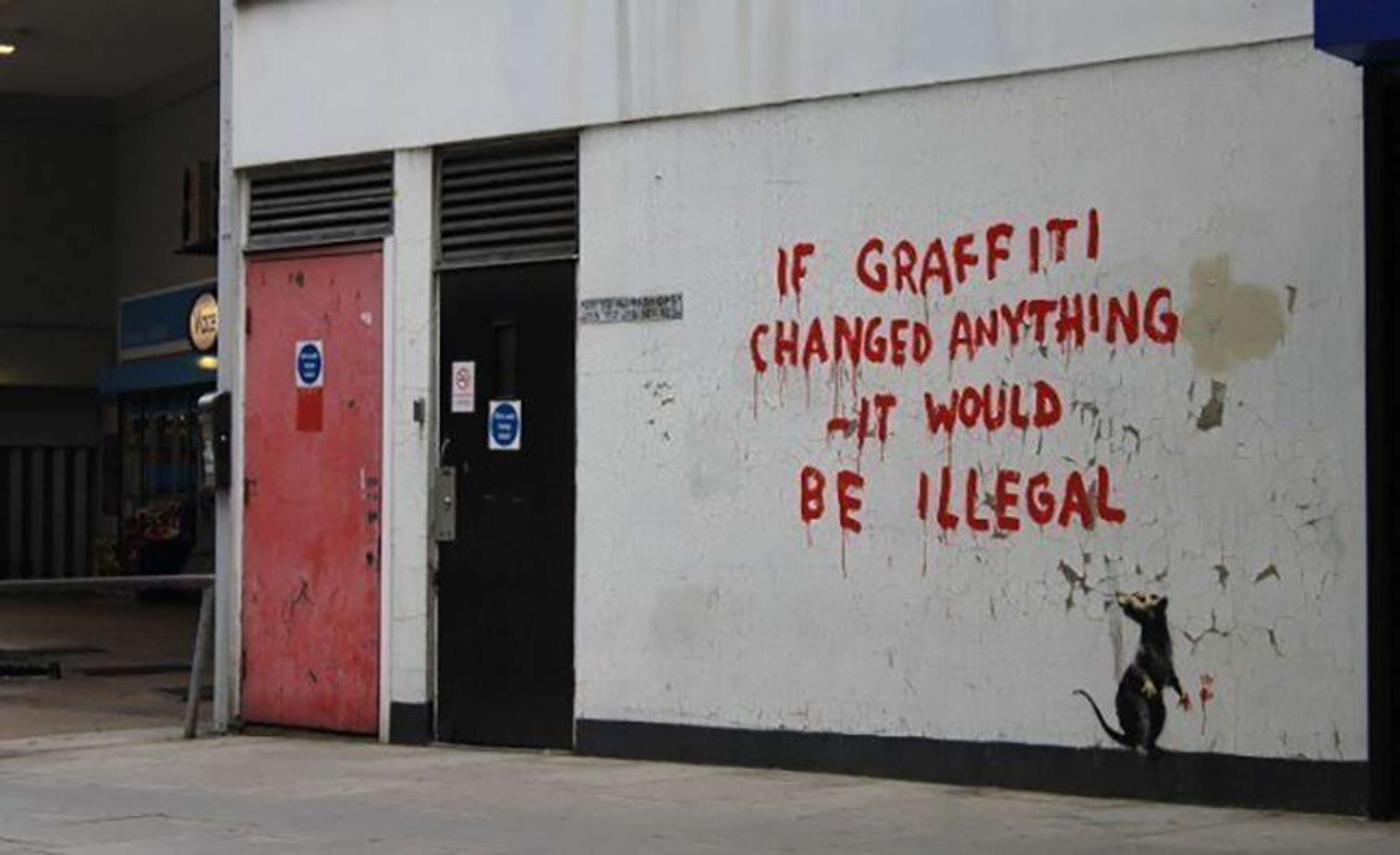 If Graffiti Changed Anything It Would Be Illegal © Banksy 2011
If Graffiti Changed Anything It Would Be Illegal © Banksy 2011If Graffiti Changed Anything It Would Be Illegal, 2011, Clipstone Street, Fitzrovia
Banksy’s If Graffiti Changed Anything It Would Be Illegal mural is located on a wall on Clipstone Street, Fitzrovia and appeared overnight on Easter Monday in 2011. It depicts one of Banksy’s iconic rats underneath the writing in red reading, “If graffiti changed anything, it would be illegal”. This is a reference to a quote by 20th century political activist Emma Goldman who campaigned for Women’s rights, her words were: “If voting ever changed anything, it would be illegal”.
Shortly after it appeared, a local campaign was launched to save the mural from removal by Westminster City Council. Today, it is protected by a layer of Perspex, even though much of it has been covered in tags and graffiti. Many of Banksy’s early works have been removed due to damage, theft, or being painted over. Refer to Banksy Wall Murals Since 2000 for a comprehensive list of all his street art pieces.
 Guard Dog and His Master's Voice © Banksy 2003
Guard Dog and His Master's Voice © Banksy 2003Guard Dog and His Masters Voice, 2003, Rivington Street, Shoreditch
These two pieces of graffiti are among Banksy’s earliest works in the British capital, located in the courtyard of the night club Cargo in the heart of Shoreditch, now protected with perspex. This courtyard is a hub for various well-known graffiti artists, including French artists C215 and Thierry Noir, Israeli artists from Broken Fingaz Crew and the Italian artist, Ozmo. Banksy acknowledges Rivington Street's legacy in Designated Graffitti Area, also known as Guard Dog, with the ironic, self-explanatory text. The figurative element, Guard Dog is a mockery of the police and the authorities, depicting a policeman and his poodle on patrol in a designated graffiti area.
His Master’s Voice, also referred to as HMV Dog, was released as a print in 2003 and makes a pop culture reference to the logo of music shop HMV, designed after a painting by Francis Barraud. Banksy's work features a dog pointing a bazooka towards a gramophone. The image highlights the contrast between conservatism represented by the vintage gramophone and progressive youth ideals embodied by the rebel animal.
The HMV logo, moreover, will be recognisable given the shop's turbulent affairs in recent years—having monopolised on the counter-culture of record shops, it has since succumbed to economic difficulties as a result of its mainstream consumerism. Banksy pokes fun at the company's troubles, but likely also makes a genuine remark on the demise of British high streets.
Banksy's anti-establishment attitudes have always been rooted in reference to counter-cultural music genres, for example, as in Grannies.
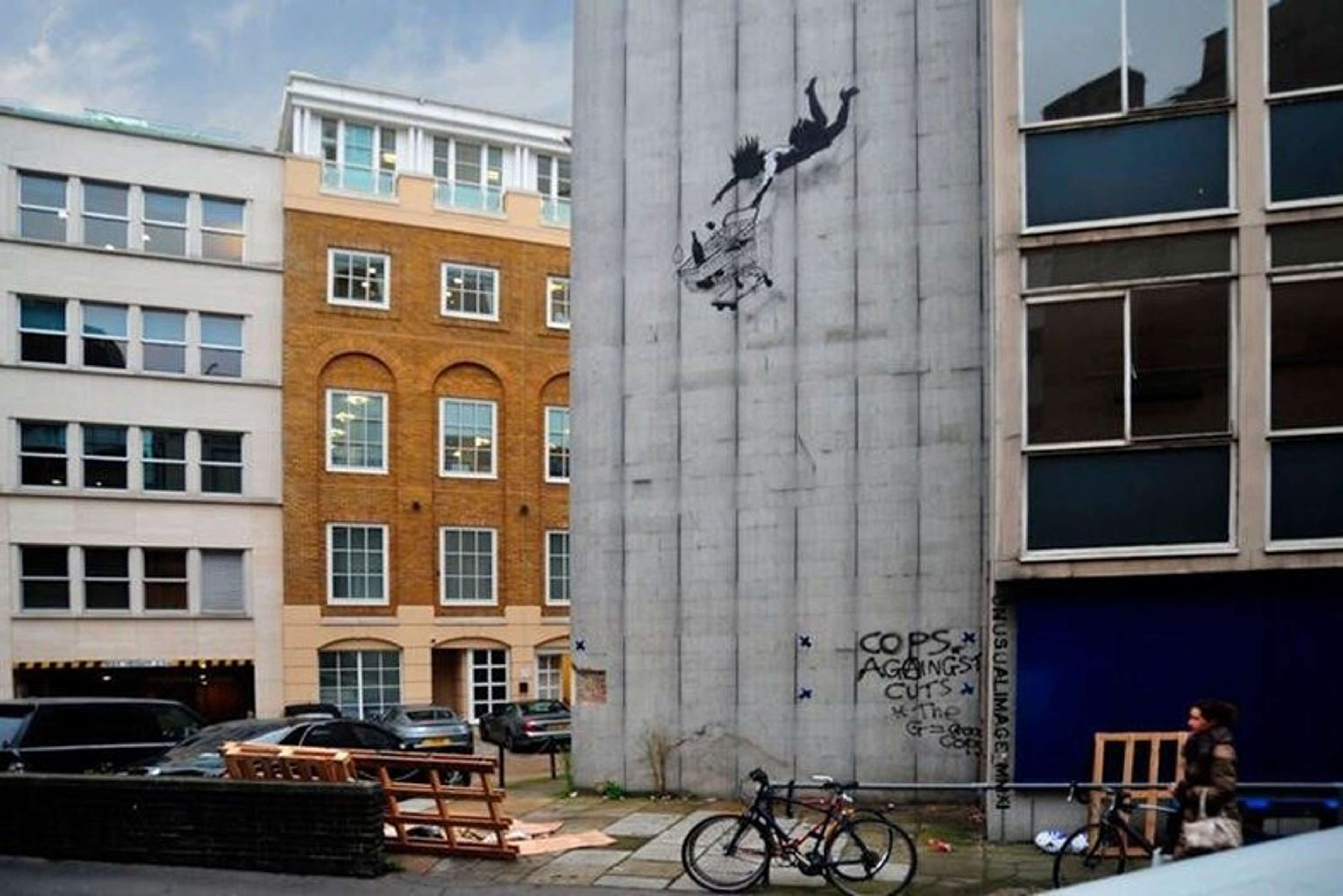 Shop Till You Drop © Bansky 2011
Shop Till You Drop © Bansky 2011Shop Till You Drop, 2011, Bruton Lane, West End
Also known as the Falling Shopper, this Banksy mural is located on Bruton Lane on the side of a large office building in the heart of the commercial West End district. Impressively, the mural was painted in November 2011 in broad daylight. A scaffolding and a tarpaulin were used to make sure nobody caught the artist red-handed. Shop Till You Drop is still visible, even if quite damaged.
Towering over passers-by from more than two stories high, the mural features Banksy's signature stencilled female figure, reminiscent of his early street works, with a shopping trolley in freefall from the top of a building. Banksy’s aim was to point out the dangers of consumerism, which is a topic he revisits often in his limited editions prints such as in the work Festival (Destroy Capitalism).
Banksy's critique of consumerism and capitalism is one of the most controversial themes of his art, not least because his artworks–in particular, Banksy's record-breaking originals–frequently sell for very large sums of money. Explore our take on the matter in Banksy and Capitalism: Critic or Champion?
 Very Little Helps © Bansky 2008
Very Little Helps © Bansky 2008Very Little Helps, 2008, Essex Road, North London
Also known as Tesco Kids, Banksy’s Very Little Helps mural is located on Essex Road, North London. Painted in 2008 on the side of a pharmacy, the artwork portrays three children pledging allegiance to the British supermarket chain Tesco. One child raises a Tesco carrier bag on a flagpole in a mock ceremonial gesture. The image is a critique on society’s reliance on mass consumerism and multinational corporations. Banksy also released Very Little Helps as a print in 2008.
Even though it was quickly covered in Perspex, Very Little Helps has been vandalised on several occasions and it is currently partially damaged. The flag has been painted over and replaced with a tag from Robbo, a graffiti artist who often targets Banksy’s works.
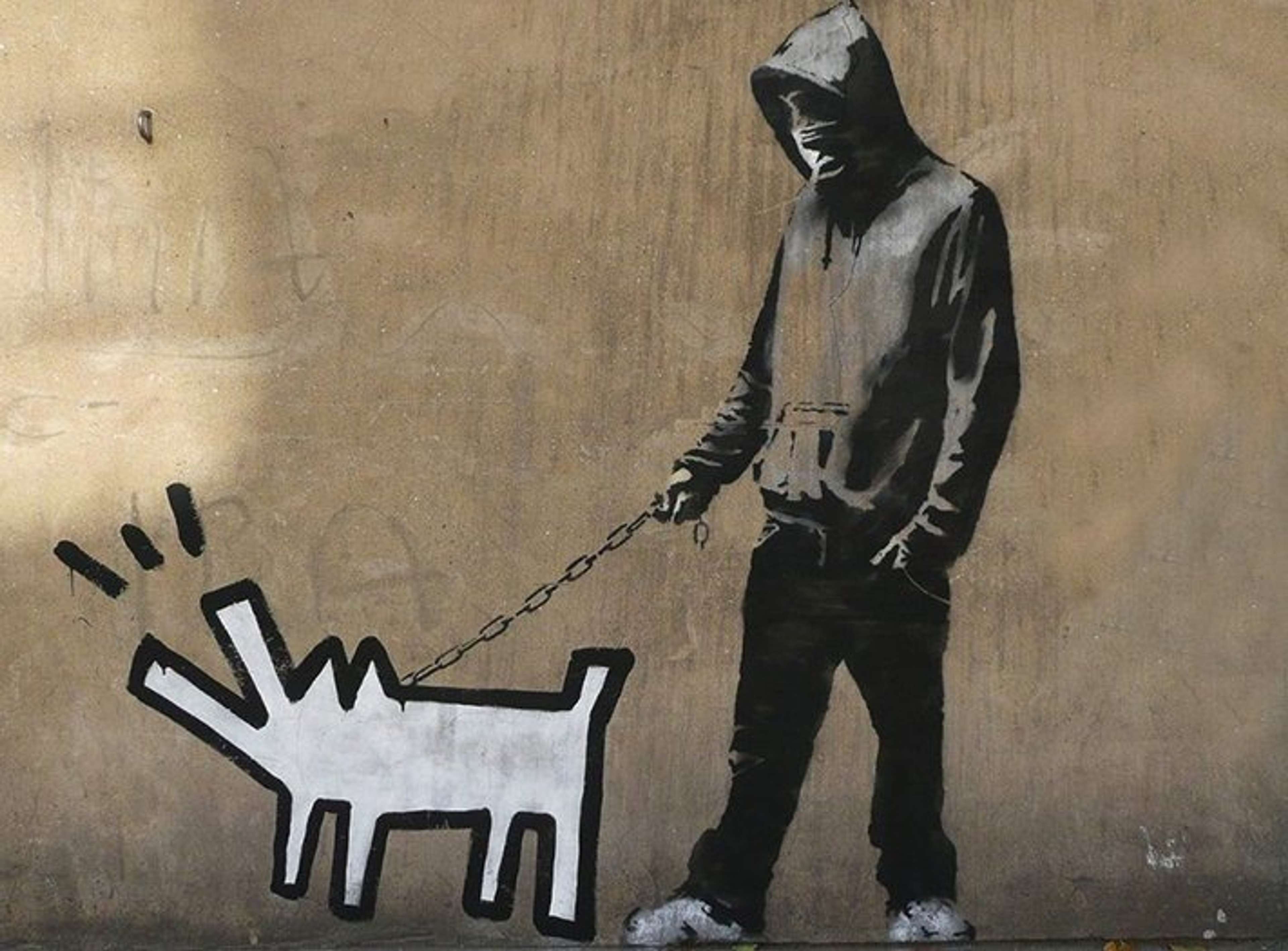 Choose Your Weapon © Bansky 2008
Choose Your Weapon © Bansky 2008Choose Your Weapon, 2008, The Grange, Bermondsey
This mural appeared on a wall in The Grange in Bermondsey, South London in 2010. The artwork was boarded over shortly after. It’s one of Banksy’s most well-known images of a hooded man with a barking dog on a leash that is a tribute to legendary artist Keith Haring’s Barking Dog. There is a sharp contrast between the cartoon-like dog and its master’s hyper realistic representation. Banksy often references other famous artists in his work, such as Andy Warhol in Soup Can.
Choose Your Weapon was released as a print in multiple colors in 2010 and remains the most recent original print from Banksy, now highly sought after on the secondary market. To learn more about the market performance of this print as part of the collection series, and the varying demand for specific colourways, access The Banksy Report: Seven Years In The Banksy Market.
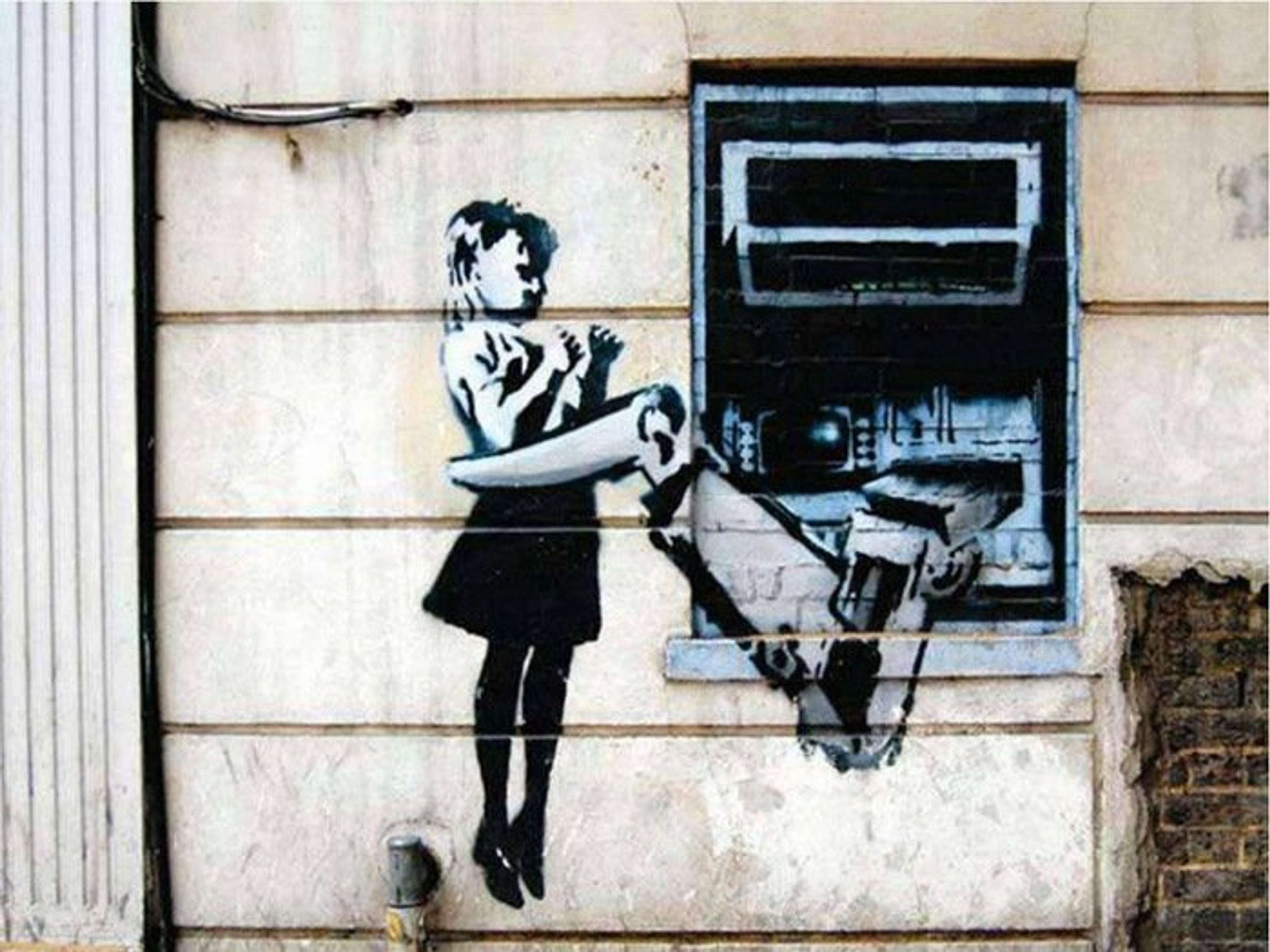 Cash Machine Girl © Bansky 2007
Cash Machine Girl © Bansky 2007Cash Machine Girl, 2007, Exmouth Market, North London
Banksy’s Cash Machine Girl was created in May 2008, close to Exmouth Market in North London. The artwork depicts a young girl being lifted by the eerie robotic arm emerging from a cash machine.
Much like with other murals like Shop Till You Drop, or with Banksy’s limited edition prints like Sale Ends, this artwork appears to have a blatantly anti-capitalist message, warning passers-by about the corrupt power of banks and how you can easily become ‘kidnapped’ by capital. Like many of Banksy's early works, this mural has since been painted over.
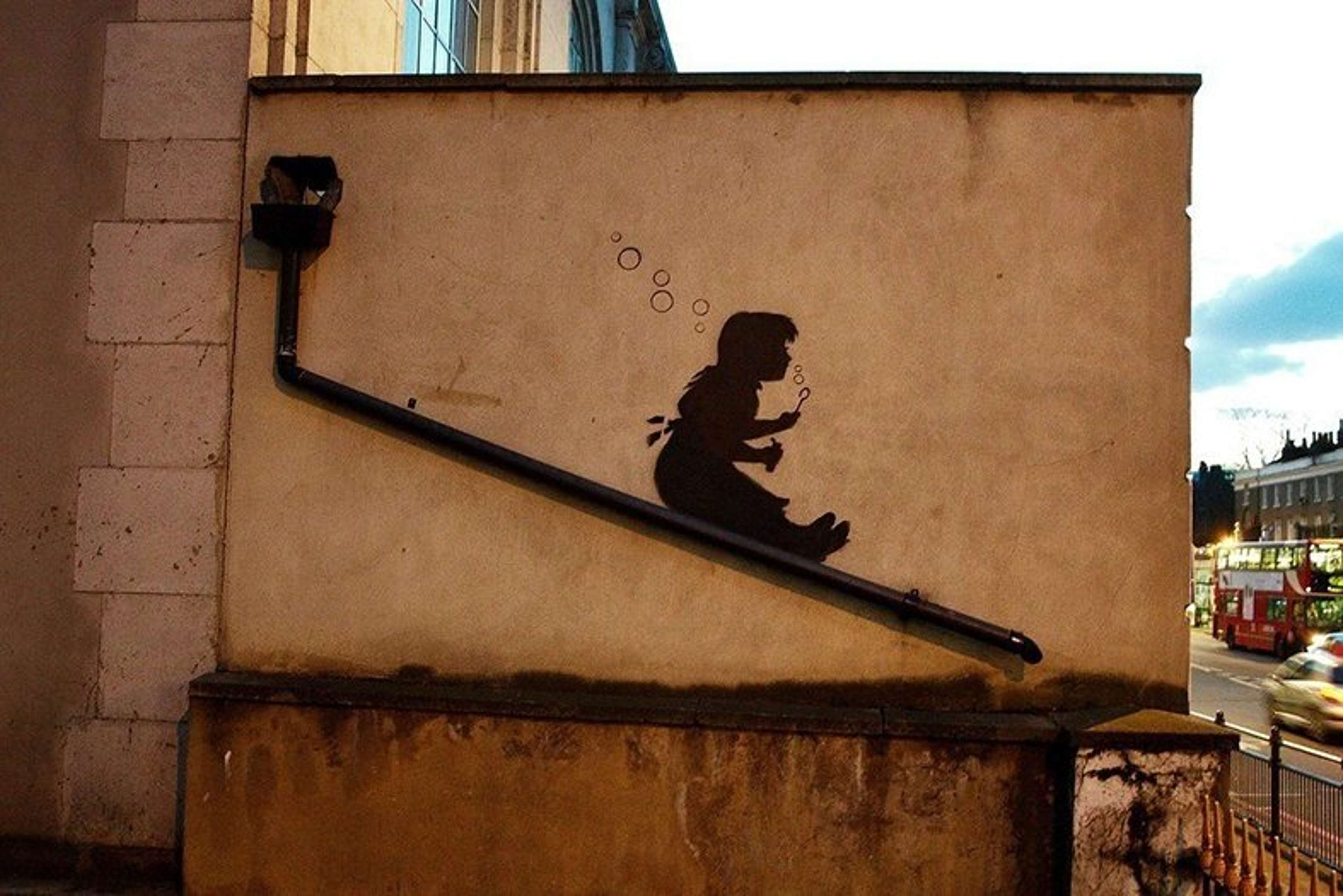 Bubble Slide Girl © Bansky 2008
Bubble Slide Girl © Bansky 2008Bubble Slide Girl, 2008, Hackney, East London
Banksy’s playful Bubble Slide Girl mural was painted onto the sidewall of a youth club in Hackney around February 2008. Now, only a faint outline of this work is still visible since it has been removed. The image depicts a little girl blowing bubbles and using a drainpipe as a slide. This piece from Banksy carries a more uplifting message, suggesting that by embracing playfulness and maintaining a childlike, light-hearted attitude, we can find silver linings and adapt to difficult circumstances.
The famous print Girl With Balloon, painted as a mural in London's Southbank in 2022, and released as a print in 2004 contains a similarly uplifting message and a sense of hope. The mural in Southbank London, accompanied by a quote reading “there is always hope” before it was eventually painted over by the council.
 Phone Tap © Bansky 2011
Phone Tap © Bansky 2011Phone Tap, 2011, Chrisp Street, Poplar
The quirky Phone Tap mural can be found in a small car park on Chrisp Street in East London, just two minutes away from All Saints DLR station. It has remained quite intact since 2011 even though there are some multicoloured paint splatters around it. This is one example of how Banksy incorporates the natural urban environment into his murals – he depicts a phone ringing to an actual water tap on the street.
Next to it stands a stick figure with a baffled expression saying, “Oh no… my tap’s been phoned”. This stencil work is a tongue-in-cheek reference to the Rupert Murdoch phone hacking scandal that was all over the media in the summer of 2011. It also engages with the theme of surveillance that is omnipresent throughout Banksy’s works, including prints like Radar Rat from his famous Rat series released in 2004.
This mural exemplifies why anonymity is important to Banksy's practice: at the time, it likely would be difficult to reference an incident as controversial as Murdoch's phone-tapping as a high profile artist and not get taken to court for libel without having a pseudonymous identity. Moreover, Banksy's choice to remain anonymous even as an established artist underscores his deep-seated wariness of surveillance and social awareness.
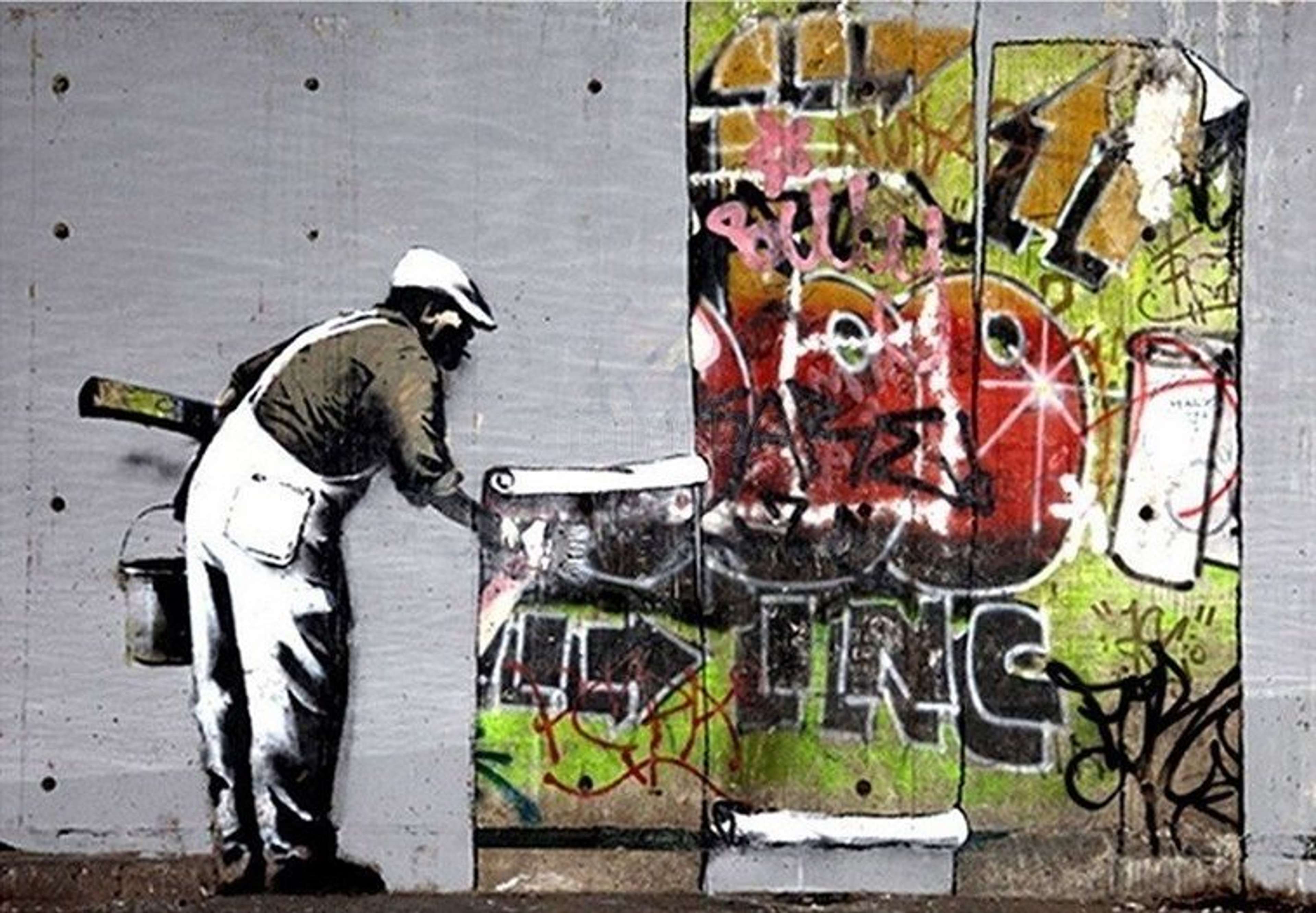 Wallpaper Hanging © Bansky 2009
Wallpaper Hanging © Bansky 2009Wallpaper Hanging, 2009, Regents Canal, Camden
Banksy’s Wallpaper Hanging is located beside Regent’s Canal tunnel and under the London Transport Police Headquarters in Camden. The mural, painted in 2009, represents a city worker in Banksy’s iconic stencil style, covering the work of another graffiti artist painted in 1985 with grey wallpaper.
This particular wall became the battleground of a graffiti war between Banksy and the now deceased London graffiti legend King Robbo. Shortly after, Robbo struck back and covered Banksy’s piece on the pretext that he broke the underground code of conduct.
The wall had undergone eight other modifications from both artists. The feud stopped when King Robbo was hospitalised for life-threatening head injuries. When Banksy heard about King Robbo’s serious health condition, he painted an ode to Robbo’s original graffiti piece. As a tribute to Robbo, the mural was restored to its original form with slight changes.
 I Love Robbo Rat © Bansky 2004
I Love Robbo Rat © Bansky 2004I love Robbo Rat, 2004, Chiswell Street, Islington
I love Robot Rat is another example of the graffiti war between Banksy and Robbo. Painted on Chiswell Street in Islington, Banksy’s piece depicts a stencilled ghetto rat holding a placard which originally read “London doesn’t work”, created in 2004. Later it received a tag from Robbo, who reworked the placard by adding his own name in red letters.
The placard rat motif is depicted in various limited edition prints like Welcome to Hell and Get Out While You Can in 2004. Banksy’s rats are among his most well-known and popular pieces, which have shown a noteworthy increase in market value over the years. Recently, at Phillips' 2024 October London sale, Banksy's Rat and Heart (2014), a rare framed spray-paint on board, achieved £317,500 with fees in its first public auction appearance. You can read more about Banksy's rats here.
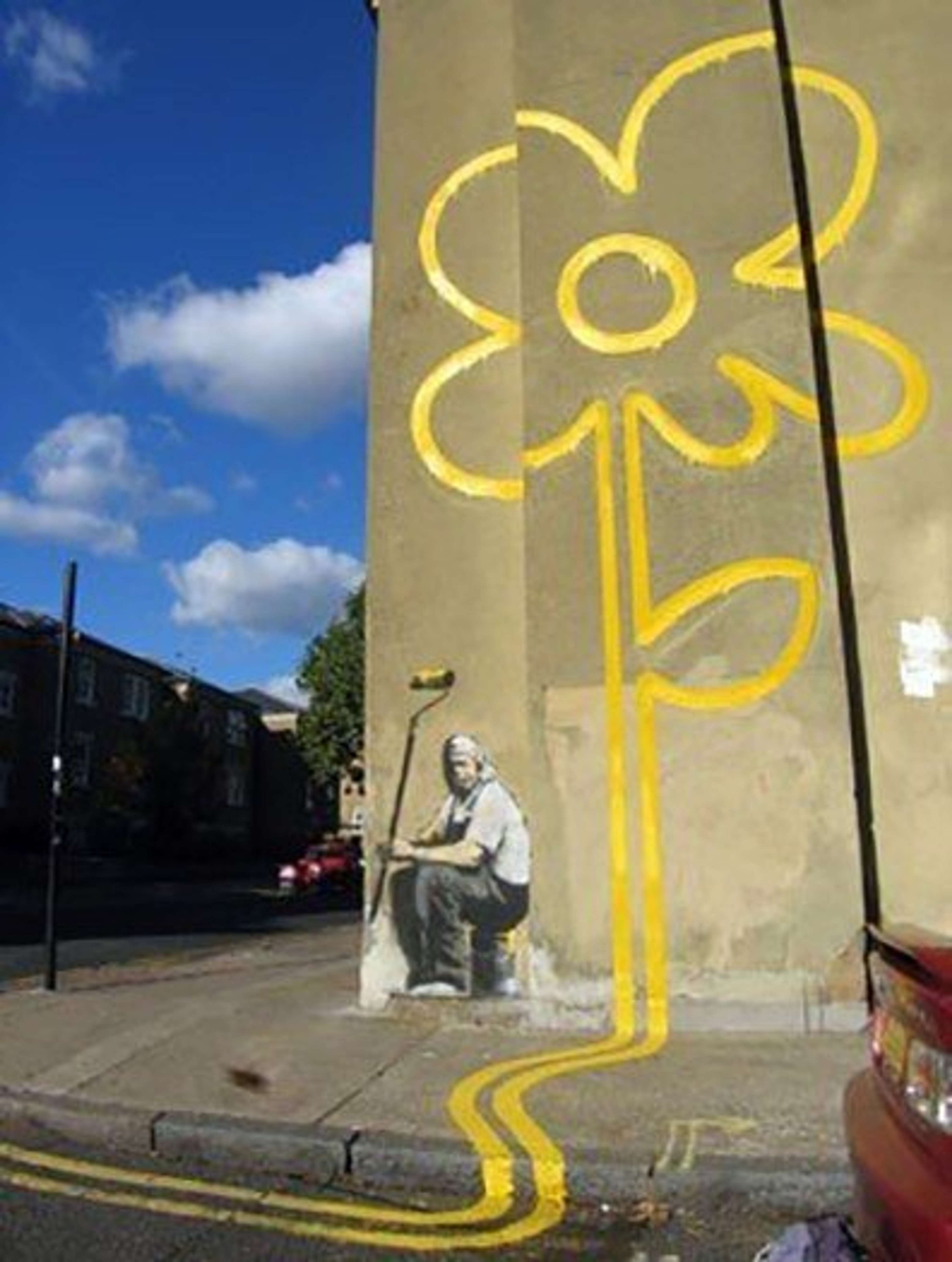 Yellow Flower © Bansky 2007
Yellow Flower © Bansky 2007Yellow Flower, Pollard Street, Bethnal Green
The large-scale, striking Yellow Flower mural on Pollard Street around Bethnal Green shows how Banksy incorporates existing features of the urban landscape to complete his work. He painted an extension the double yellow lines of the road across the pavement to crawl up the wall and bloom into a bright, cartoonish yellow flower that deters from his traditional style. With a large-scale street artwork like this, which heavily relies on its original setting for context, it's clear why street art rarely makes its way to auction.
 Tox © Banksy 2011
Tox © Banksy 2011Tox, 2011, Jeffrey Street, Camden
This Banksy stencil figure appeared on Jeffrey Street in Camden in June 2011, as an addition to graffiti artist Daniel Halpin’s, aka Tox’s, tag. Tox was previously convicted for tagging multiple locations in London over a period of three years and was mocked as ‘no Banksy’ by the prosecution due to his lack of creative artistry with his graffiti works.
As a response, Banksy created an artwork of a little boy blowing the Tox tag as a bubble–whether as an act of solidarity or to make fun of the other artist is up to the public to decide. It’s undoubtedly one of his cheekier pieces that stays true to his graffiti artist roots and shows his enduring connection to the London scene.
 Image © Dezeen 2012 / Royal Family © Banksy 2009
Image © Dezeen 2012 / Royal Family © Banksy 2009London Zoo
The most recent and complex, yet playful, display of Banksy’s street art emerged in the summer of 2024 as a series of murals across London dubbed as Banksy's London Zoo. While the art market is typically quiet during this time, Banksy stirred up excitement, leading fans on a scavenger hunt with stencilled animals scattered throughout the city. This work can be seen as Banksy’s interpretation of the art historical concept of Gesamtkunstwerk, meaning “total work of art,” where various artistic elements come together, culminating in a mural at the London Zoo featuring a gorilla releasing animals. Some of the murals, as far as we know, remain intact, while others have been removed, damaged, or stolen.
 Royal Courts Of Justice © Banksy 2025
Royal Courts Of Justice © Banksy 2025Royal Courts Of Justice
Revealed on Monday 8th September via Banksy’s official Instagram, the Royal Courts mural came with a rare caption: “. Royal Courts of Justice, London”. The use of a full stop and precise location is highly uncharacteristic – less a title than a direct statement. It adds a forensic quality to the work, as if placing it on official record. The image itself is stark: two persons, a judge and a protestor, in violent conflict, their instruments of justice turned into weapons. Above them, a surveillance camera sits motionless – positioned to observe, yet deliberately turned away. It doesn’t just miss the violence; it refuses to acknowledge it. That refusal was mirrored the next day, when the mural was pressure-washed off the wall - the blank patch left behind now reads as part of the work, a shadowy history of the erasure.
Considering the timing of the work, it bears a convincing draw to the recent legal developments surrounding Palestine Action, whose appeal against its classification under UK legislation was rejected by the Royal Courts. While the mural makes no explicit reference, its themes – state power, protest, selective accountability – resonate sharply in the current climate. As ever, Banksy leaves space for interpretation, but the placement and timing speak volumes.
Given just how prolific Banksy has been at decorating the streets of London, it is impossible to mention every mural. And, just as many artworks have appeared, many have sadly been lost, too. Small but worthy footnotes to this non-exhaustive list include Banksy’s rats, which, scattered as they are throughout London, are perhaps most magical when discovered by accident. Perhaps they are instructive in this regard: while many comprehensive maps (such as the one below) exist of London’s Banksys, there’s never too far to wander in any given borough before you might find an iconic Banksy mural.
Custom Google Map of Banksy's Top London Locations by Steve Cotton (artofthestate.co.uk), 2022.
To discover more about street art refer to Banksy Wall Murals Since 2000. To explore areas on where to find exisiting street art read our Top 10 Places to Find an Invader Original.





